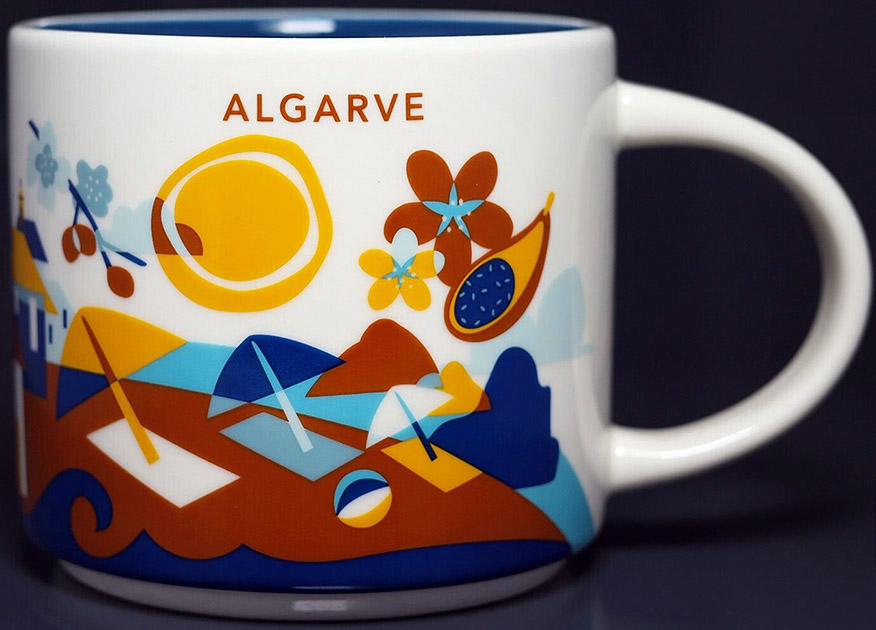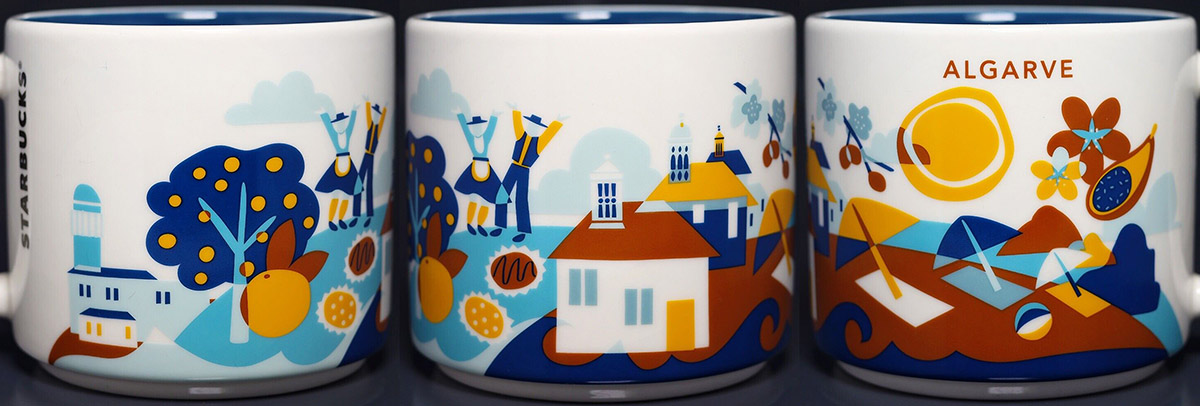
You Are Here – Algarve
Starbucks You Are Here – Algarve mug features one of my favorite color palettes. The sun is another interesting detail that I’ve seen on some other mugs from Europe (like this or this).
The Algarve is a historical province located in southern Portugal. It is bounded by the Atlantic Ocean to the south and west, and the lower Guadiana River to the east. The region has a diverse landscape, with a fertile coastal lowland and a sparsely populated interior upland region .
The history of the Algarve is rich and varied. The Phoenicians established bases in the area, and later, the Romans conquered it. The region was ruled by the Visigoths until the Muslims took control in the early 8th century. After nearly five centuries of Muslim rule, the Algarve was taken into the Portuguese kingdom in 1189. However, it still retains some of its Moorish characteristics .
During the 15th century, the Algarve became a center of maritime exploration and trade. Henry the Navigator founded a research center in Sagres in 1419, which came to be known as a school of navigation. This period marked the beginning of Portugal’s Age of Discovery, with explorers like Vasco da Gama setting sail from the Algarve in search of new trade routes
Here are some towns of Algarve that you might want to visit:
– Tavira is a captivating town with a rich history. It was a former Roman settlement and features a medieval-esque old quarter, a hilltop castle, and the Ponte Romana (Roman Bridge), which is a 17th-century reconstruction of the original Roman work. Visitors can also explore the Núcleo Islâmico, which houses a collection of 11th-century pieces from the Algarve’s days under Islamic rule .
– Lagos is renowned for its dining and nightlife. It offers beautiful beaches, historical sites, and a vibrant atmosphere. The town has a rich maritime history and was an important center during the Age of Discovery. Visitors can explore the historic old town, visit the Lagos Fortress, and enjoy the lively nightlife .
– Silves is a historic town known for its well-preserved Moorish castle, which offers panoramic views of the surrounding area. The town also has a charming old quarter with narrow streets and traditional whitewashed houses. Silves was once the capital of the Algarve during the Moorish period .
– Faro is the capital city of the Algarve and is known for its historic center, which is surrounded by medieval walls. The city has a beautiful cathedral, charming cobblestone streets, and a picturesque harbor. Visitors can also explore the Ria Formosa Natural Park, a unique coastal lagoon ecosystem
The pair of people that we see closer to the back of the mug is probably symbolizing the corridinho, a traditional Portuguese folk dance native to the Algarve region. It gained popularity in the 1800s and is known for its lively and energetic nature. The dance is performed in a round, accompanied by small flutes, fifes, and later, the accordion. The corridinho has left a lasting legacy and is still popular in former Portuguese colonies like Goa, Macau, and parts of Malaysia. It consists of three parts, including a fast-paced section called the corrido. Overall, the corridinho is a vibrant and cherished part of Portuguese culture, reflecting the traditions of the Algarve region.
Algarve is renowned for its unique style of Fado music, characterized by soulful melodies and poignant lyrics. Local performers often showcase this traditional genre in intimate settings, creating a profound connection with the audience.
Medronho, a traditional spirit of the Algarve region in Portugal, holds a special place in local culture. Crafted from the fruit of the arbutus tree, the medronho berry, this strong alcoholic beverage is both a symbol of tradition and a testament to the resourcefulness of the people of Algarve. The process of making medronho involves careful fermentation and distillation, resulting in a unique and potent drink. Often enjoyed as a digestif, medronho captures the essence of the region, offering a taste that reflects the sun-soaked landscapes and the rich agricultural heritage of Algarve.
Characterized by its plump and tender texture, the figs from Algarve thrive under the region’s abundant sunshine and moderate climate. Rich in flavor and nutritional value, these figs are often enjoyed fresh, dried, or as a key ingredient in local culinary delights.




































































